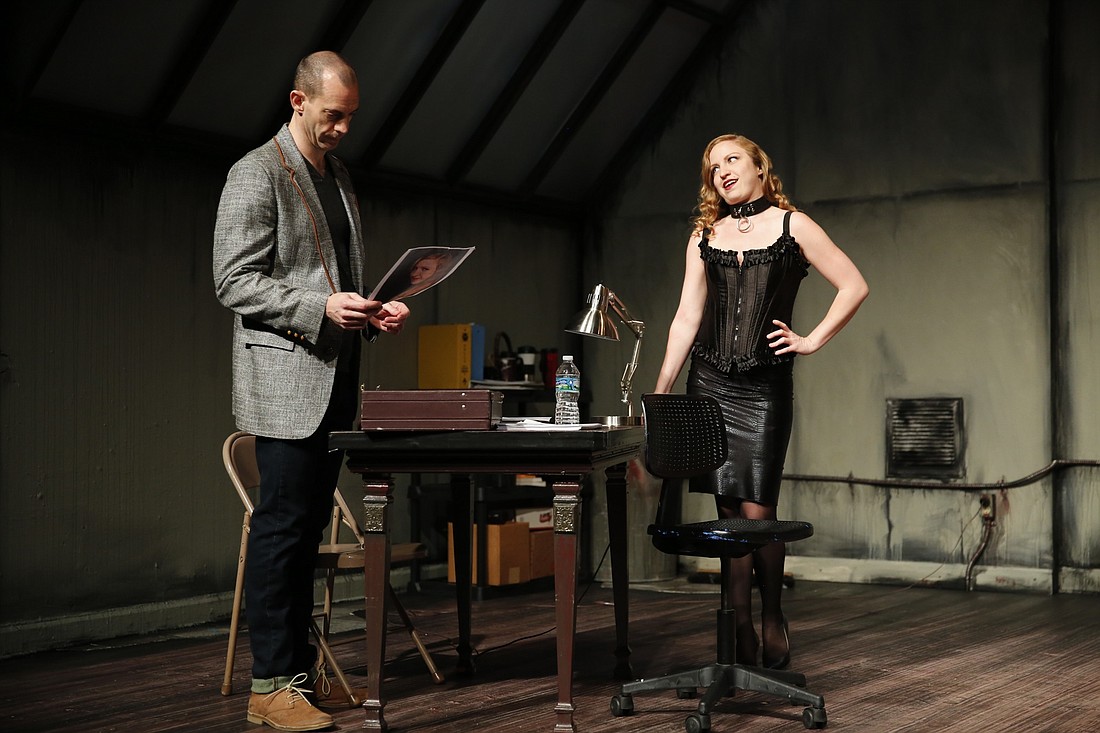- May 19, 2025
-
-
Loading

Loading

David Ives’ “Venus in Fur” explores the intersection of sex, power, submission, dominance, modern theater and pagan splendor at Venice Theatre. That may sound like a tall order, but the play delivers.
The premise: director/playwright Thomas Novachek has adapted Leopold von Sacher-Masoch kinky “Venus in Furs” for the stage. (The Masoch in question being the man who gave his name to masochism.) All he needs now is the perfect dominatrix for the female lead. But his audition has been a perfect disaster.
As the play opens, Thomas (Steve O’Dea) sits alone in a seedy audition room. It’s been a long day full of bad actresses. Now he’s ready to go home. But there’s a sound of thunder—and Vanda (Vera Samuels) stumbles in, like a wet cat coming in out of the rain. A young actress, wearing a trench coat and not much else. She loudly complains about the rain, fate, the subway and the creeps who ride it. Vanda wants to audition, but she’s not on the list. But she begs and bullies and Thomas finally agrees to give her a chance. (This means the director has to read for the part of Severin—which isn’t standard operating procedure.) Vanda initially wows him. But she’s almost too good. It’s one of many warning signs Thomas doesn’t pick up on: Vanda has mysteriously got her hands on his script; she’s memorized it; she’s also got perfect period costumes; she knows too much about Thomas fiancé; and she’s got the same name as the character. But Thomas ignores those signs, entranced. Before too long, he gets into his role. Reality and theater blur. Thomas started out in charge, but Vanda takes control. And it’s clear she’s got something planned for him. I’d tell you … But that would be telling.
The play goes to some strange places. Director Kelly Woodland grounds the disorienting journey with a firm grasp on reality. You always think you’re looking at a real director and a real actress in a real audition room. When the play pulls a Magical Realist rabbit out of its hat at the end, you’re all the more surprised.
O’Dea and Samuels have great chemistry together—bubbling with volatility as they alternate between their characters in the play and their roles in the play-within-a-play. They’re both great psychological quick-change artists; all their little changes turn their characters into different people by the play’s end. O’Dea’s Thomas starts out as the alpha dog. You see the character’s tough side before he winds up wearing a dog collar. Samuels’ Vanda initially seems to lack all boundaries—as nearly naked psychologically as she is physically. But she’s not what she seems.
Scenic designer’s Tim Wisgerhof shabby audition room is such an excellent set, you might not know it’s a set at first. Nice job on the faux concrete! Costume designer Jonathan Hall does great work, even on the skimpiest of costumes.
It’s an electrifying night of theater—and not for the easily offended. Think adult language and situations. And what weird situations they are. This is both a risqué play and a risky one. But Ives’ amazing language is the real burlesque.
Crime and suspense novelist Elmore Leonard boasted, “I leave out the parts that people skip.” Ives takes that approach to playwriting. There’s no fat in his script. The second you get a handle on where the play’s going, it zips someplace else. One place it takes you is a weird mix of theater and criticism. Among other things, “Venus in Fur” is a critique of the original “Venus in Furs.” Vanda points out the source material’s many implied insults to women. And Thomas pays the price.
The resolution recalls the classic twist endings of the EC horror comics. (Which I mean as high praise.) Ives hides it in plain sight. You won’t see it coming.
Once you do, you’ll keep your cell phone on in strange places.
And respect all women.
Especially the strange ones.